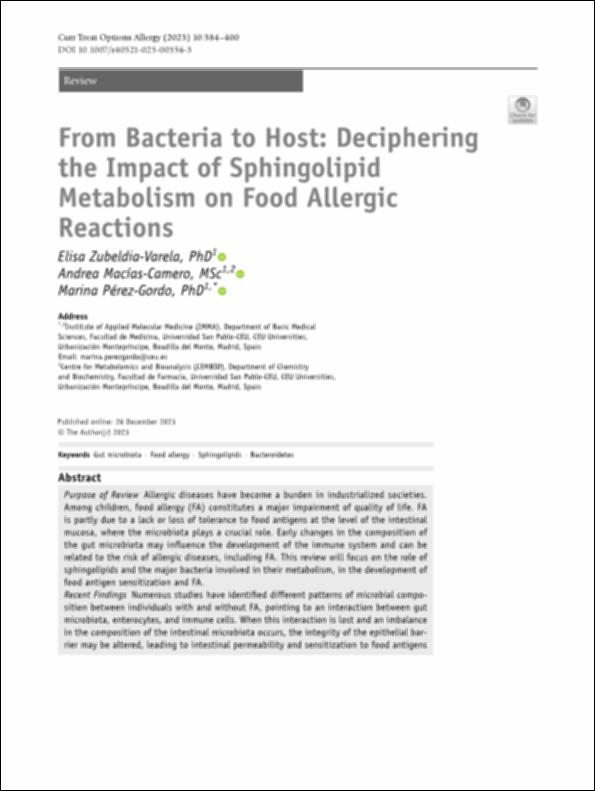Please use this identifier to cite or link to this item:
http://hdl.handle.net/10637/15753From Bacteria to Host: Deciphering the Impact of Sphingolipid Metabolism on Food Allergic Reactions
| Title: | From Bacteria to Host: Deciphering the Impact of Sphingolipid Metabolism on Food Allergic Reactions |
| Authors : | Zubeldia Varela, Elisa Macías Camero, Andrea Pérez Gordo, Marina |
| Keywords: | Allergic diseases; Allergy; Food allergy |
| Publisher: | Springer Link |
| Citation: | Zubeldia-Varela, E., Macías-Camero, A. & Pérez-Gordo, M. From Bacteria to Host: Deciphering the Impact of Sphingolipid Metabolism on Food Allergic Reactions. Curr Treat Options Allergy 10, 384–400 (2023). https://doi.org/10.1007/s40521-023-00356-3 |
| Abstract: | Purpose of Review Allergic diseases have become a burden in industrialized societies. Among children, food allergy (FA) constitutes a major impairment of quality of life. FA is partly due to a lack or loss of tolerance to food antigens at the level of the intestinal mucosa, where the microbiota plays a crucial role. Early changes in the composition of the gut microbiota may influence the development of the immune system and can be related to the risk of allergic diseases, including FA. This review will focus on the role of sphingolipids and the major bacteria involved in their metabolism, in the development of food antigen sensitization and FA. Recent Findings Numerous studies have identified different patterns of microbial composition between individuals with and without FA, pointing to an interaction between gut microbiota, enterocytes, and immune cells. When this interaction is lost and an imbalance in the composition of the intestinal microbiota occurs, the integrity of the epithelial barrier may be altered, leading to intestinal permeability and sensitization to food antigens and the development of FA. Gram- negative bacteria, especially those of the Proteobacteria phylum, have been associated with the development of FA. Investigating the interactions between the intestinal microbiota and the immune system, their influence on intestinal barrier function, and their production of metabolites and signaling molecules may contribute to understanding the pathogenesis of FA. Summary Sphingolipids, a class of bioactive amphipathic lipids found in cell membranes, have emerged as critical regulators of inflammation. In this review, we will attempt to summarize the existing knowledge on the role of these molecules and the major bacteria involved in their metabolism in the mechanisms underlying sensitization to food antigens and the development of FA. |
| URI: | http://hdl.handle.net/10637/15753 |
| Rights : | http://creativecommons.org/licenses/by-nc-nd/4.0/deed.es Open Access |
| ISSN: | 2196-3053 |
| Issue Date: | 26-Dec-2023 |
| Center : | Universidad San Pablo-CEU |
| Appears in Collections: | Medicina |
Items in DSpace are protected by copyright, with all rights reserved, unless otherwise indicated.


